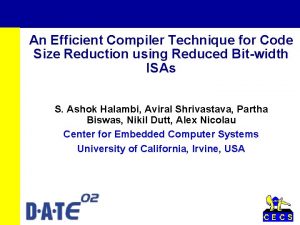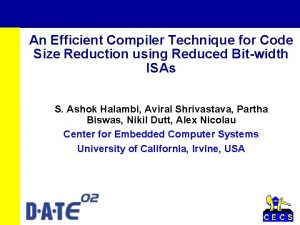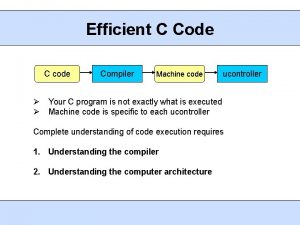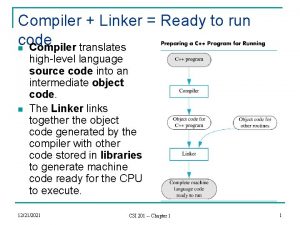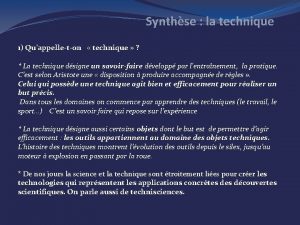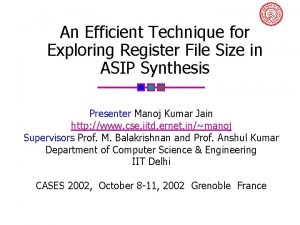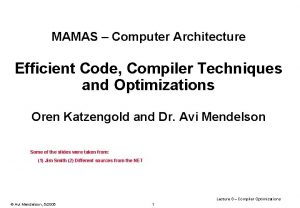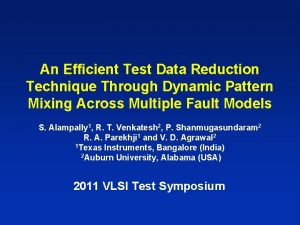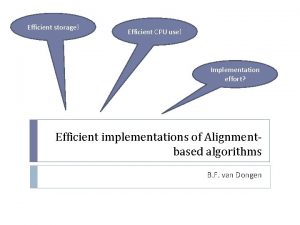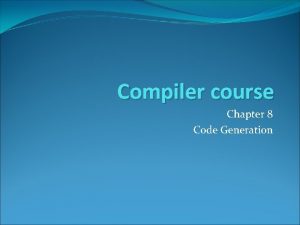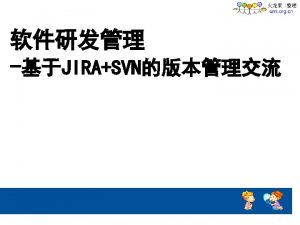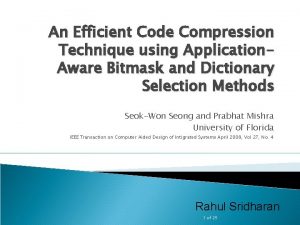An Efficient Compiler Technique for Code Size Reduction




























- Slides: 28

An Efficient Compiler Technique for Code Size Reduction using Reduced Bit-width ISAs S. Ashok Halambi, Aviral Shrivastava, Partha Biswas, Nikil Dutt, Alex Nicolau Center for Embedded Computer Systems University of California, Irvine, USA

Outline • • • Introduction to r. ISA Challenges Problem definition Existing approach Our approach Architectural Model for r. ISA Compiling for r. ISA Summary Future directions 2

Introduction • Code Size is a critical design factor for many Embedded Applications. • “reduced bit-width Instruction Set Architecture” is a promising architectural feature for code size reduction. • Support for a “reduced Bit-width Instruction Set”, along with normal IS. • Many contemporary processors use this feature • ARM 7 TDMI, MIPS, ST 100, ARC-Tangent. 3

reduced Bit-width Instruction Set • The “reduced Bit-width Instruction Set” along with the supporting hardware is termed “reduced Bitwidth Instruction Set Architecture (r. ISA)”. • r. ISA Features • Instructions from both the IS reside in the memory. • r. IS are dynamically expanded to normal instructions before or during decode stage. • Execution of only normal instructions. 4

r. ISA • Most frequently occurring instructions are compressed to make reduced Bit-width Instruction Set. • Each r. ISA instruction maps to a unique normal instruction. • Simple and fast lookup table based “translator” logic. • Can be implemented without increasing cycle length or cycle penalty. • Achieve good code size reduction, without much architectural modification. • Best Case : 50 % code size reduction 5

Architectures supporting r. ISA • ARM 7 TDMI • • 32 -bit normal IS, and 16 -bit r. IS. Switching between normal and r. ISA instructions is done by BX (Branch Exchange) instruction. – Basic block level granularity. • • Kwon et. al made each r. ISA instruction to write to a partition of register file. MIPS • • 32 -bit normal IS, and 16 -bit r. IS. Switching between normal and r. ISA instructions is done implicitly by code alignment. – Routine not aligned to word bounday r. ISA Instructions. – Routine level granularity. • ST 100 from STMicro and Tangent ARC core also support r. ISA 6

Bit-width Restrictions • Only a few instructions in r. IS. • Not all normal instructions can be converted to r. ISA instructions. • 7 -bit opcodes in a 3 -address ARM Thumb instruction. • Operands of r. ISA instructions can access only a part of register file. • Code in terms of r. ISA instructions has high register pressure causing extra move/load/store instructions. • 3 -address instructions in ARM Thumb have accessibility to only 8 registers (out of 16). 7

Challenges in code generation 16 -bit r. ISA instruction format 7 -bit Fewer opcodes • 3 -bit Accessibility to only 8 registers Register pressure increases in the block which contains r. ISA instructions, resulting in • • • 3 -bit Increased code size because of spilling. Performance degradation. Estimating code size increase due to spilling, before register allocation is difficult. • A heuristic to estimate spill code because of r. ISA might be useful. 8

Problem Definition • Compile for r. ISA to achieve – • Maximum code size reduction. • Least degradation in performance. 9

Existing Compilers for r. ISA • Work on routine level or basic-block level granularity. • • Convert to reduced bit-width instructions only if all the instructions in the routine/basic-block have mappings to r. ISA instructions. Code generation for r. ISA is done as a postassembly pass or a pre-instruction selection pass. 10

Our Approach • r. ISA architectural model contains a mode exchange instruction to change mode at an instruction level granularity. • Code generation for r. ISA is done as a part of instruction selection • • • Tightly coupled with the compiler flow. Use r. ISA instructions whenever profitable even within a function. We term the process of code generation for r. ISA, r. ISAization. 11

Advantage of Our Approach Existing approach Our approach Function 1 32 bit 16 bit Function 1 Function 2 Function 3 • Function level granularity • Instruction level granularity • Higher Code density 12

Architectural Model • • r. ISA instructions to normal instructions mapping. Explicit mode exchange instructions (mx and r. ISA_mx). • • Allow instruction level granularity for Conversion to r. ISA instructions. Useful r. ISA instructions: • • r. ISA_nop: To align the code to word boundary. r. ISA_move: To access all the registers in the register file and minimize spills in r. ISA code. r. ISA_extend: To increase the length of the immediate in the successive instruction. The bit-width restrictions for the above three r. ISA instructions are relaxed because they have lesser number of operands. 13

Compiling for r. ISA Source File C/C++ gcc Front End Generic Instruction Set 3 -address code Instruction Selection - I Profitability Analysis Augmented Instruction Set (with r. ISA Blocks) Instruction Selection - II Register Allocation Target Instruction Set (Normal + r. ISA) Assembly 14

Compiling for r. ISA – An Example Source File C/C++ gcc Front End Generic Instruction Set 3 -address code G_ADD GR 1 GR 2 4 G_MUL GR 3 GR 1 GR 2 G_ADD GR 4 GR 3 1 G_SUB GR 4 16 G_LI GR 4 200 G_ADD GR 5 GR 6 GR 7 G_MUL GR 9 GR 8 GR 6 G_ADD GR 10 GR 5 GR 9 G_SUB GR 11 GR 10 R 7 15

Compiling for r. ISA – An Example Source File C/C++ gcc Front End 1. Mark Instructions that can be converted to r. ISA instructions. Generic Instruction Set G_ADD GR 1 GR 2 4 3 -address code G_MUL GR 3 GR 1 GR 2 G_ADD GR 4 GR 3 1 Instruction Selection - I Augmented Instruction Set (with r. ISA Blocks) G_SUB GR 4 16 G_LI GR 4 200 G_ADD GR 5 GR 6 GR 7 G_MUL GR 9 GR 8 GR 6 Candidates for r. ISA instructions G_ADD GR 10 GR 5 GR 9 G_SUB GR 11 GR 10 GR 7 16

Compiling for r. ISA – An Example Source File C/C++ gcc Front End 2. Decide whether it is profitable to convert a r. ISA Block. Generic Instruction Set G_ADD GR 1 GR 2 4 3 -address code G_MUL GR 3 GR 1 GR 2 G_ADD GR 4 GR 3 1 Instruction Selection - I Profitability Analysis Augmented Instruction Set (with r. ISA Blocks) G_SUB GR 4 16 G_LI GR 4 200 G_ADD GR 5 GR 6 GR 7 G_MUL GR 9 GR 8 GR 6 G_ADD GR 10 GR 5 GR 9 G_SUB GR 11 GR 10 GR 7 17

Compiling for r. ISA – An Example Source File C/C++ gcc Front End 3. Replace marked instructions with r. ISA instructions. Generic Instruction Set T_ADD_R GR 1 GR 2 4 3 -address code T_MUL_R GR 3 GR 1 GR 2 T_ADD_R GR 4 GR 3 1 Instruction Selection - I Profitability Analysis Augmented Instruction Set (with r. ISA Blocks) Instruction Selection - II Target Instruction Set (Normal + r. ISA) T_SUB_R GR 4 16 T_MX_R T_LI GR 4 200 T_ADD GR 5 GR 6 GR 7 T_MUL GR 9 GR 8 GR 6 T_ADD GR 10 GR 5 GR 9 T_SUB GR 11 GR 10 GR 7 18

Compiling for r. ISA – An Example Source File C/C++ gcc Front End 4. Perform register allocation. Generic Instruction Set T_ADD_R TR 1 TR 2 4 3 -address code T_ADD_R TR 4 TR 3 1 Instruction Selection - I Profitability Analysis T_SUB_R TR 4 16 Augmented Instruction Set (with r. ISA Blocks) Instruction Selection - II Register Allocation T_MUL_R TR 3 TR 1 TR 2 Target Instruction Set (Normal + r. ISA) T_MX_R T_LI TR 4 200 T_ADD TR 5 TR 6 TR 7 T_MUL TR 9 TR 8 TR 6 T_ADD TR 10 TR 5 TR 9 T_SUB TR 11 TR 10 TR 7 Assembly 19

Compilation for r. ISA Source File C/C++ gcc Front End Generic Instruction Set 3 -address code 1. Mark Instructions that can be converted to r. ISA instructions. • Contiguous marked instructions form a “r. ISA Block”. Instruction Selection - I Profitability Analysis Generic Instruction Set (with r. ISA Blocks) Instruction Selection - II Register Allocation Target Instruction Set (Normal + r. ISA) 2. Decide whether it is profitable to convert a r. ISA Block. 3. Replace marked instructions with r. ISA instructions. 4. Perform register allocation. Assembly 20

Profitability Heuristic • Decides whether or not to convert a r. ISA Block to r. ISA Instructions. • Ideal decrease in code size – r. ISA_block_size(normal. Mode) – r. ISA_block_size(r. ISAMode) • Increase in code size – CS 1 : due to mode change instructions. – CS 2 : due to NOPs. – CS 3 : due to extra r. ISA load/store/move instructions. 21

Register Pressure Heuristic • Estimate the extra spill/load/move instructions. CS 3 = Spill/Reload code needed if block is converted to r. ISA Instructions – Spill/Reload code needed if block is converted to normal instructions • Spill code for a block is a function of • • • average register pressure number of instructions average live length 22

Spill Code Estimation • Estimate extra average register pressure: average register pressure – K 1*number of registers • Estimate the number of spills needed to reduce the register pressure by 1 for the block: number of instructions / average live length • Estimate number of spills: average extra register pressure * number of spills needed to reduce the register pressure by 1 23

Register Pressure Heuristic • Spill code if converted to r. ISA = (1) + (2) (1) Estimated spill code for r. ISA variables in block number of available registers = r. ISA RF size (2) Estimated spill code for non-r. ISA variables in block. number of available registers = RF size – r. ISA RF size – average extra r. ISA register pressure • Spill code if converted to normal IS Estimated spill code for all variables in block number of available registers = RF size • Reload code is estimated as: K 2 * Spill code * average number of uses per variable definition 24

Experimental Set-up • Platform : MIPS 32/16 architecture • Benchmarks : Livermore loops • Baseline Compiler: GCC for MIPS 32 and MIPS 16 optimized for code size • %age code size reduction in MIPS 16 over MIPS 32 • Our Compiler : Retargetable EXPRESS compiler for MIPS 32/16 • %age code size reduction • %age Performance degradation 25

Experiments § EXPRESS achieves 38% while GCC 14% average code size reduction. § Performance impact: average 6% (worst case: 24%) 26

Summary • r. ISA is an architectural feature that can potentially achieve huge code size reduction with minimal hardware alterations. • We presented a compiler technique to achieve code size reduction using r. ISA. • Ability to operate at instruction level granularity. • Integration of this technique in the compiler flow. • A heuristic to estimate the amount of spills/reloads/moves due to restricted availability of registers by some instructions. • On an average 38% improvement in code size. 27

Future directions • The profitability heuristic for code generation can be modified to account for the performance degradation due to r. ISA. • Design space exploration for choosing the best r. ISA suitable for a given embedded application. 28
 Productively efficient vs allocatively efficient
Productively efficient vs allocatively efficient Productively efficient vs allocatively efficient
Productively efficient vs allocatively efficient Productively efficient vs allocatively efficient
Productively efficient vs allocatively efficient Allocative efficiency vs productive efficiency
Allocative efficiency vs productive efficiency Productive inefficiency and allocative inefficiency
Productive inefficiency and allocative inefficiency Yacc tutorial
Yacc tutorial Cross compiler in compiler design
Cross compiler in compiler design Code commit code build code deploy
Code commit code build code deploy Why there is a need for size separation
Why there is a need for size separation Apa yang dimaksud dengan pengecilan ukuran
Apa yang dimaksud dengan pengecilan ukuran Fluid energy mill
Fluid energy mill Disadvantage of size reduction
Disadvantage of size reduction Réduction de dimension
Réduction de dimension Condensation translation technique
Condensation translation technique Intermediate code
Intermediate code Compiler code generation
Compiler code generation Language
Language Code reduction alitalia
Code reduction alitalia![Const int size=18; string *tb12 = new string[size]; Const int size=18; string *tb12 = new string[size];](data:image/svg+xml,%3Csvg%20xmlns=%22http://www.w3.org/2000/svg%22%20viewBox=%220%200%20200%20200%22%3E%3C/svg%3E) Const int size=18; string *tb12 = new string[size];
Const int size=18; string *tb12 = new string[size]; Formuö
Formuö Typiska novell drag
Typiska novell drag Nationell inriktning för artificiell intelligens
Nationell inriktning för artificiell intelligens Vad står k.r.å.k.a.n för
Vad står k.r.å.k.a.n för Varför kallas perioden 1918-1939 för mellankrigstiden
Varför kallas perioden 1918-1939 för mellankrigstiden En lathund för arbete med kontinuitetshantering
En lathund för arbete med kontinuitetshantering Adressändring ideell förening
Adressändring ideell förening Tidböcker
Tidböcker Sura för anatom
Sura för anatom Förklara densitet för barn
Förklara densitet för barn














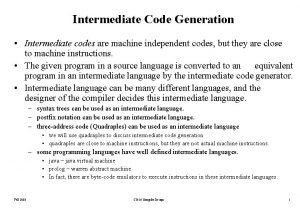
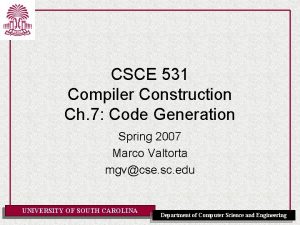
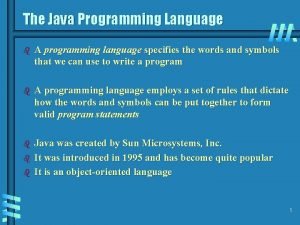

![Const int size=18; string *tb12 = new string[size]; Const int size=18; string *tb12 = new string[size];](https://slidetodoc.com/wp-content/uploads/2020/11/1588947_40cf3415d0afabae1c436a49b39f4ad0-300x225.jpg)










